Die Casting of Lightweight Thin Fin Heat Sink Using Al-25%Si
Abstract
1. Introduction
2. Experimental Conditions
3. Results and Discussion
3.1. Comparison of Al-25%Si with ADC12
3.1.1. Flow Length of ADC12 and Al-25%Si
3.1.2. Castability of ADC12 and Al-25%Si Thin Fins
3.1.3. Effect of Thermal Conductivity on Heat Dissipation
3.2. Effect of Fin Thickness on Heat Dissipation
3.3. Effect of Fin Height on Heat Dissipation
3.4. Effect of Fin Number on Heat Dissipation
3.5. Effect of Base Thickness on Heat Dissipation
3.6. Effect of Porosity and Microstructure Non-Uniformity on Heat Dissipation
4. Investigation for Practical Use
4.1. Anodization
4.2. Comparison of Heat Dissipation between Al-25%Si Heat Sink and a Commercial Heat Sink
5. Conclusions
Author Contributions
Funding
Data Availability Statement
Conflicts of Interest
References
- Car LED Lamp Heat Sink. Available online: https://www.nikkeikinholdings.co.jp/car/detail/a0180.html (accessed on 29 March 2024).
- Car LED Lamp Heat Sink. Available online: http://www.nanshin-grp.co.jp/car_product/ (accessed on 29 March 2024).
- High-Ceiling LED Lamp Heat Sink. Available online: http://ja.perfumecaps.com (accessed on 29 March 2024).
- Şevik, S.; Őzdilli, Ő.; Akbulut, F. Numerical investigation of the effect of different heat sink fin structures on the thermal performance of automotive LED headlights. Int. J. Automot. Sci. Technol. 2022, 6, 17–126. [Google Scholar] [CrossRef]
- Stafford, J.; Walsh, E.; Egn, V.; Walsh, P.; Muzychka, Y.S. A novel Approach to Low Profile Heat Sink Design. J. Heat Transf. 2010, 132, 091401. [Google Scholar] [CrossRef]
- Kim, E.J.; Kim, D.K.; Oh, H.H. Comparison of Fluid Flow and Thermal Characteristics of Plate-Fin and Pin-Fin Heat Sinks Subject to Parallel Flow. Heat Transf. Eng. 2008, 29, 169–177. [Google Scholar] [CrossRef]
- Mallikarjuna, V.; Rajesh, K.; Ramesh, K.; Reddy, B.R.B. Modeling and Optimization of shape of a Heat Sink Fins on Motherboard. J. Comput. Math. Sci. 2015, 65, 228–251. [Google Scholar]
- Kappranos, P. Current State of Semi-Solid Net-Shape Die Casting. Metals 2019, 9, 1301. [Google Scholar] [CrossRef]
- See, A.; Caporale, L. High Density Die Casting (HDDC): New frontiers in the manufacturing of heat sinks. J. Phys. Conf. Ser. 2014, 525, 012020. [Google Scholar] [CrossRef]
- Jou, R.Y. Thermal analysis of LED Heat Sinks by High-Vacuum Die Casting (HVDC). Adv. Sci. Lett. 2012, 8, 421–426. [Google Scholar] [CrossRef]
- Wu, N.; Sun, M.; Guo, H.; Zie, Z.; Du, S. Enhancement effect of a diamond network on the flow boiling heat transfer characteristics of a diamond/Cu heat Sink. Energies 2023, 16, 7228. [Google Scholar] [CrossRef]
- Maiorano, L.P.; Castillo, R.; Molina, J.M. Al/Gf composite foams with SiC-engineered interfaces for the next generation of active heat dissipation materials. Compos. Part A 2023, 166, 107367. [Google Scholar] [CrossRef]
- Khan, M.A.; Ali, H.M.; Rehman, T.; Arsalanloo, A.; Niyas, H. Composite pin-fin for effective hotspot reduction. Heat Trans. 2024, 53, 1816–1838. [Google Scholar] [CrossRef]
- Li, H.; Ding, L.; Li, J.; Fang, Y.; Li, G.; Shi, Y.; Zhang, Z.; Li, L. Progress in preparation of silicon carbide particulate copper composites. Shandong Chem. Ind. 2021, 50, 65–67. [Google Scholar]
- Chen, Z.; Liu, C.; Xie, Y.; Pan, Z.; Ren, S.; Qu, X. Preparation and research process of high thermal conductivity metal matrix composites. Powder Metall. Technol. 2022, 40, 40–52. [Google Scholar]
- Coia, P.; Dharmasiri, B.; Stojcevski, F.; Hayne, D.J.; Austria, E., Jr.; Akhavan, B.; Razal, J.M.; Usman, K.A.S.; Stanfield, M.K.; Henderson, L.C. Scalable electrochemical grafting of anthraquinone for fabrication of multifunctional carbon fibers. L. JMST 2024, 200, 162–175. [Google Scholar] [CrossRef]
- Gupta, M.K. Mechanical behaviors of Al6063/TiB2 composites fabricated by stir casting process. Mater. Today Proc. 2023, 82, 222–226. [Google Scholar] [CrossRef]
- Zasadzińska, M.; Strzępek, P.; Mamala, A.; Noga, P. Reinforcement of aluminium-matrix composites with glass fibre by metallurgical synthesis. Materials 2020, 13, 5441. [Google Scholar] [CrossRef]
- Haga, T.; Imamura, S.; Fuse, H. Fluidity Investigation of Pure Al and Al-Si Alloys. Materials 2022, 14, 5372. [Google Scholar] [CrossRef] [PubMed]
- JIS H 5032: 2006(E); Aluminum Alloy Die Castings. Japanese Industrial Standards: Tokyo, Japan, 2006.
- Keller, K.P. Cast heatsink Design Advantages. ITherm’98. In Proceedings of the Sixth Intersociety Conference on Thermal and Thermomechanical Phenomena in Electronic Systems (Cat. No.98CH36208), Seattle, WA, USA, 27–30 May 1998. [Google Scholar] [CrossRef][Green Version]
- Zang, Z.; Lau, E.; Botting, C.; Bahrami, M. Naturally cooled heat sinks for battery chargers. Int. J. Heat Mass Transf. 2020, 14, 118911. [Google Scholar] [CrossRef]
- Kou, H.S.; Lee, J.J.; Lai, C.Y. Thermal Analysis and Optimum Fin Length of a Heat Sink. Heat Transf. Eng. 2003, 24, 18–29. [Google Scholar] [CrossRef]
- Goshayeshi, H.R.; Ampofo, F. Heat Transfer by Natural Convection from a Vertical and Horizontal Surfaces Using Vertical Fins. Int. J. Energy Power Eng. 2009, 1, 85–89. Available online: http://www.scirp.org/journal/epe (accessed on 2 November 2022). [CrossRef][Green Version]
- Kobayashi, T.; Ishikawa, A.; Hashimoto, R.; Kanematsu, H.; Utsumi, Y. Effect of Heat Sink Structure on Cooling Performance of LED Bulb. In Proceedings of the 3rd International Conference on Design Engineering and Science, ICDES, Pilsen, Czech Republic, 31 August–3 September 2014; pp. 171–174. [Google Scholar]
- Shengxiong, C.; Daqing, Z. Heat Analysis and Optimal Design of Heat Sink of LED Fish Aggregation Lamp. Sens. Mater. 2018, 30, 907–917. [Google Scholar] [CrossRef]
- Charles, R.; Wang, C.C. A novel heat dissipation fi design applicable for natural convection augmentation. Int. Commun. Heat Mass Transfer. 2014, 59, 24–29. [Google Scholar] [CrossRef]
- Jain, Y.; Kurkute, V.; Deshmukh, S.M.; Pathan, K.A.; Attar, A.R. The influence of Plate Fin Heat Sink Orientation under Natural Convection on Thermal Performance: An Experimental and Numerical Study. J. Adv. Res. Fluid Mech. Therm. Sci. 2024, 114, 118–129. [Google Scholar] [CrossRef]
- Rasangika, A.H.D.K.; Nasif, M.S.; Pao, W.; Al-Waked, R. Effect of fin spacing on the vibration-assisted thermal performance of hat sink. IOP Conf. Ser. Earth Environ. Sci. 2023, 1281, 012059. [Google Scholar] [CrossRef]
- Mani, P.; Radhakrishnan, S.; Mahalingam, A.; Vellaiyan, S. Heat dissipation effects of different nanocoated Lateral Fins an Experimental investigation. Therm. Sci. 2024, 28, 293–305. [Google Scholar] [CrossRef]
- Safari, V.; Kamkari, B.; Zandimaghm, M.; Hewitt, N. Transient Thermal Behavior of a passive heat sink integrated with phase change material: A numerical simulation. Int. J. Thermofluids 2023, 20, 100454. [Google Scholar] [CrossRef]
- Xia, G.; Zhao, H.; Zhang, J.; Yang, H.; Feng, B.; Zhang, Q.; Song, X. Study on performance of the thermoelectric cooling device with novel subchannel Finned Heat Sink. Energies 2022, 15, 145. [Google Scholar] [CrossRef]
- Byun, S.; Hyeon, S.; Lee, K.S. Guide vane for thermal enhancement of a LED heat sink. Energies 2022, 15, 2488. [Google Scholar] [CrossRef]
- Habib, N.; Siddiqi, M.U.R.; Tahir, M. Thermal analysis of proposed heat sink design under natural convection for the thermal management of electronics. Therm. Sci. 2022, 26, 1487–1501. [Google Scholar] [CrossRef]
- Ekpu, M.; Ogbodo, E.A.; Ngobigha, F.; Njoku, J.E. Thermal Effect of Cylindrical Heat Sink on Heat Management in LED Applications. Energies 2022, 15, 7583. [Google Scholar] [CrossRef]
- Moradikazerouni, A.; Afrand, M.; Alsarraf, J.; Wongwises, S.; Asadi, A.; Nguyen, T.K. Investigation of a Computer CPU Heat Sink under Laminar Forced Convection Using a Structural Stability Method. Int. J. Heat Mass Transf. 2019, 134, 1218–1226. [Google Scholar] [CrossRef]
- Wengang, H.; Lulu, W.; Zongmin, Z.; Yanhua, L.; Mingxin, L. Research on simulation and experimental of thermal performance of LED array heat sink. Procedia Eng. 2017, 205, 2084–2091. [Google Scholar] [CrossRef]
- Muneeshwaran, M.; Tsai, M.K.; Wang, C.C. Heat transfer augmentation of natural convection heat sink through notched fin design. Mass Trans. 2023, 142, 106676. [Google Scholar] [CrossRef]
- Arshad, A.; Alabdullatif, M.I.; Jabbal, M.; Yan, Y. Towards the thermal management of electronic devices: A parametric investigation of finned heat sink filled with OCM. Mass Trans. 2021, 129, 105643. [Google Scholar] [CrossRef]
- Hamid, M.B.B.; Hatami, M. Optimimization of Fins Arrangements for the square Light Emitting Diode (LED) cooling through nanofluid-filled microchannel. Sci. Rep. 2021, 11, 12610. [Google Scholar] [CrossRef] [PubMed]
- Payandeh, M.; Belov, I.; Jarfors, A.E.; Wessén, M. Effect of Material Inhomogeneity on Thermal Performance of a Rheocast Aluminum Heatsink for Electronics Cooling. J. Mater. Eng. Perform. 2016, 25, 2116–2127. [Google Scholar] [CrossRef]
- Baig, M.M.A.; Hassan, S.F.; Saheb, N.; Patel, F. Metal Matrix Composite in Heat Sink Application: Reinforcement, Processing, and Properties. Materials 2021, 14, 6257. [Google Scholar] [CrossRef]
- Die Casting Machine. Available online: https://hishinuma.jp/menu/2013/09/hc50f.html (accessed on 22 April 2022).
- Temperature Controller. Available online: https://hishinuma.jp/menu/cat/cat132/cat1/ (accessed on 22 April 2022).
- Zhang, Z.; Collins, M.; Lau, E.; Botting, C.; Bahrami, M. The Role of Anodization in Naturally Cooled Heat Sinks for Power Electronic Devices. J. Heat Transf. 2020, 142, 05290. [Google Scholar] [CrossRef]

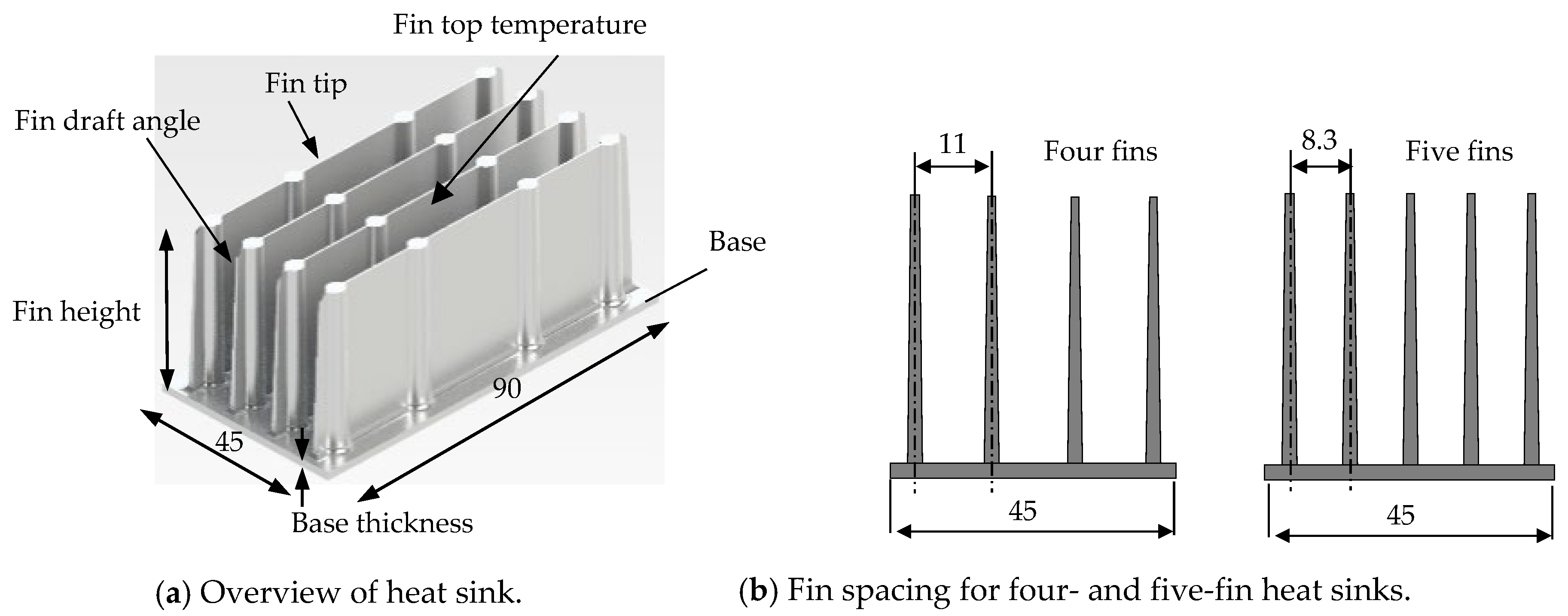
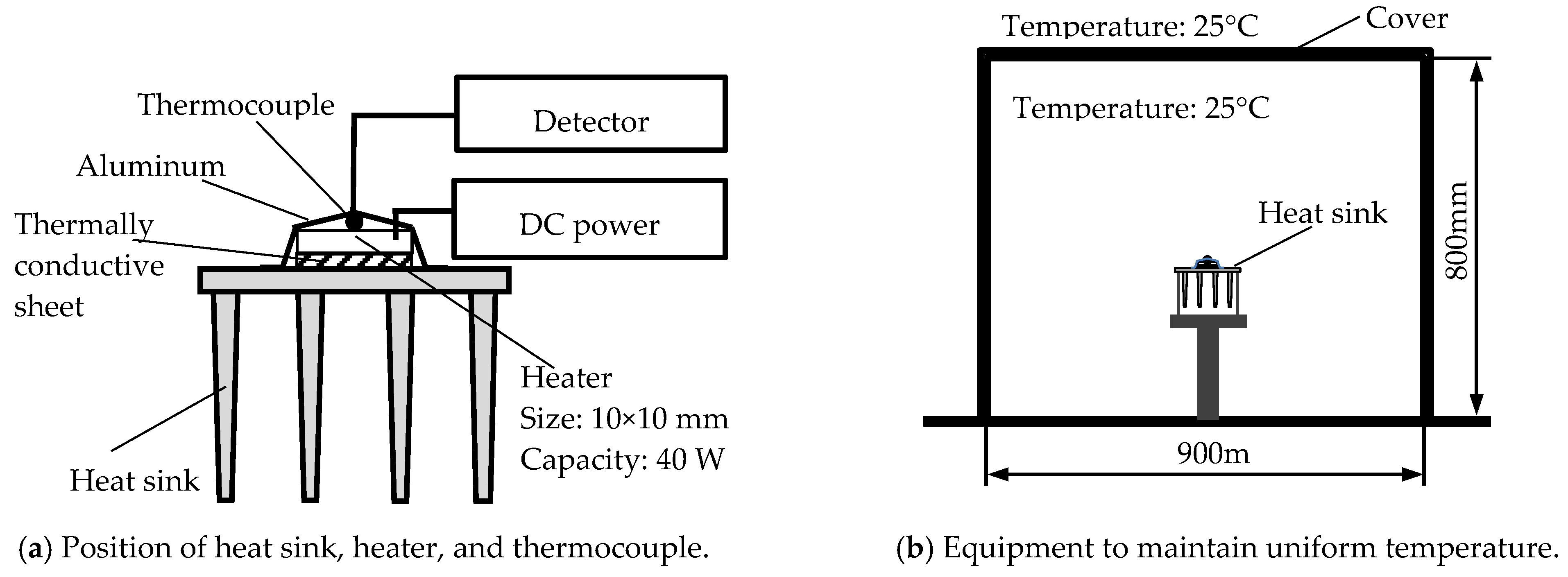
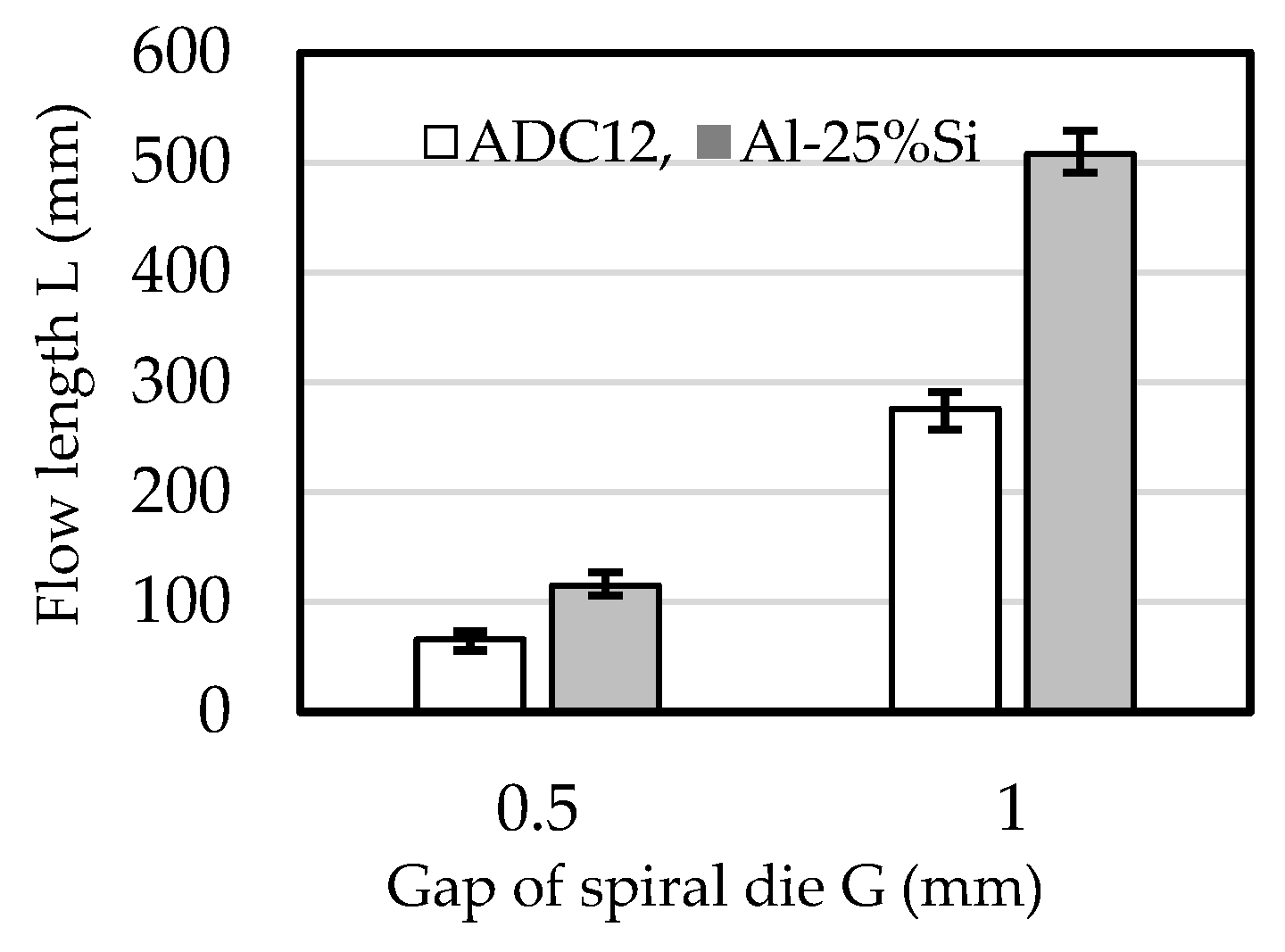

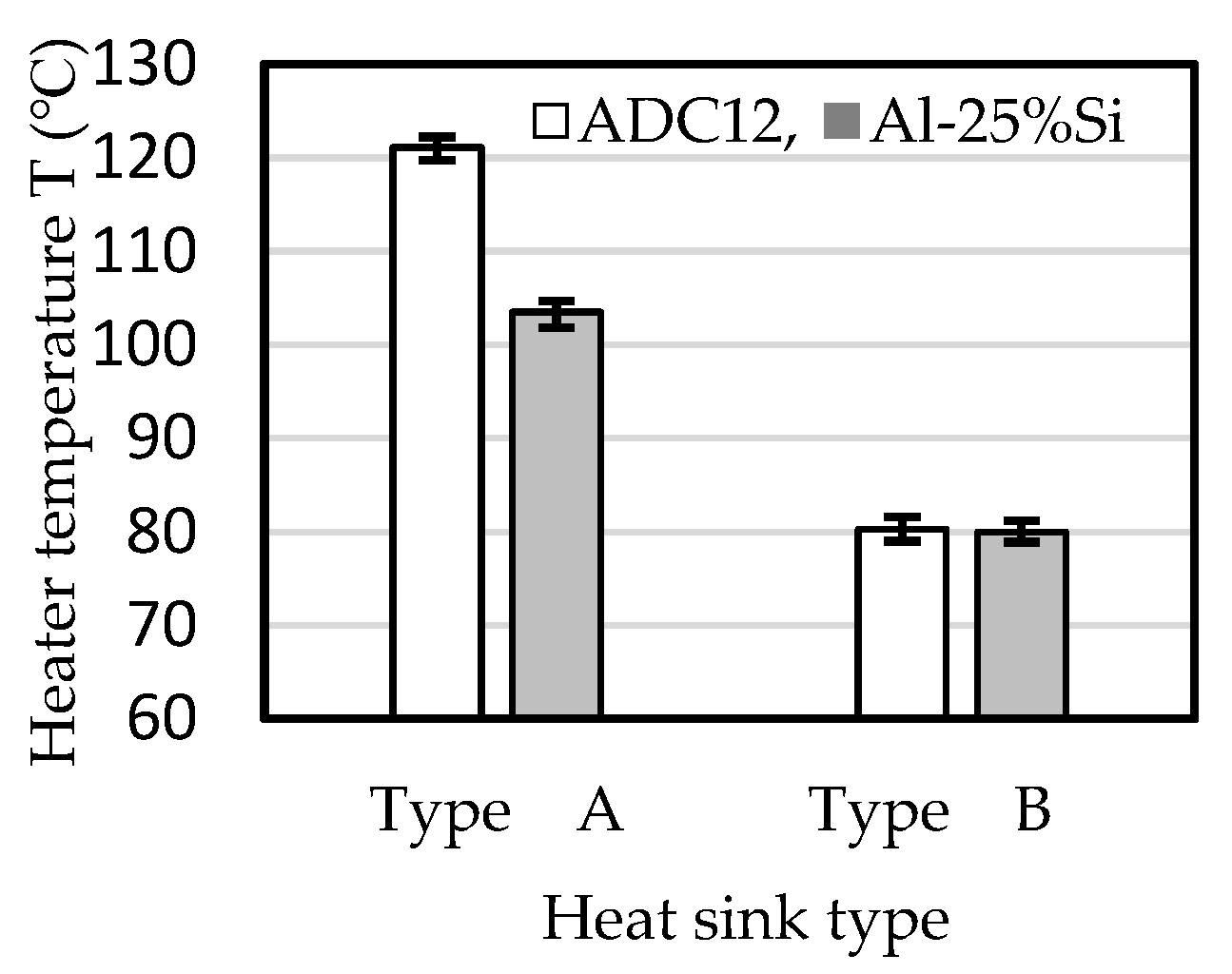
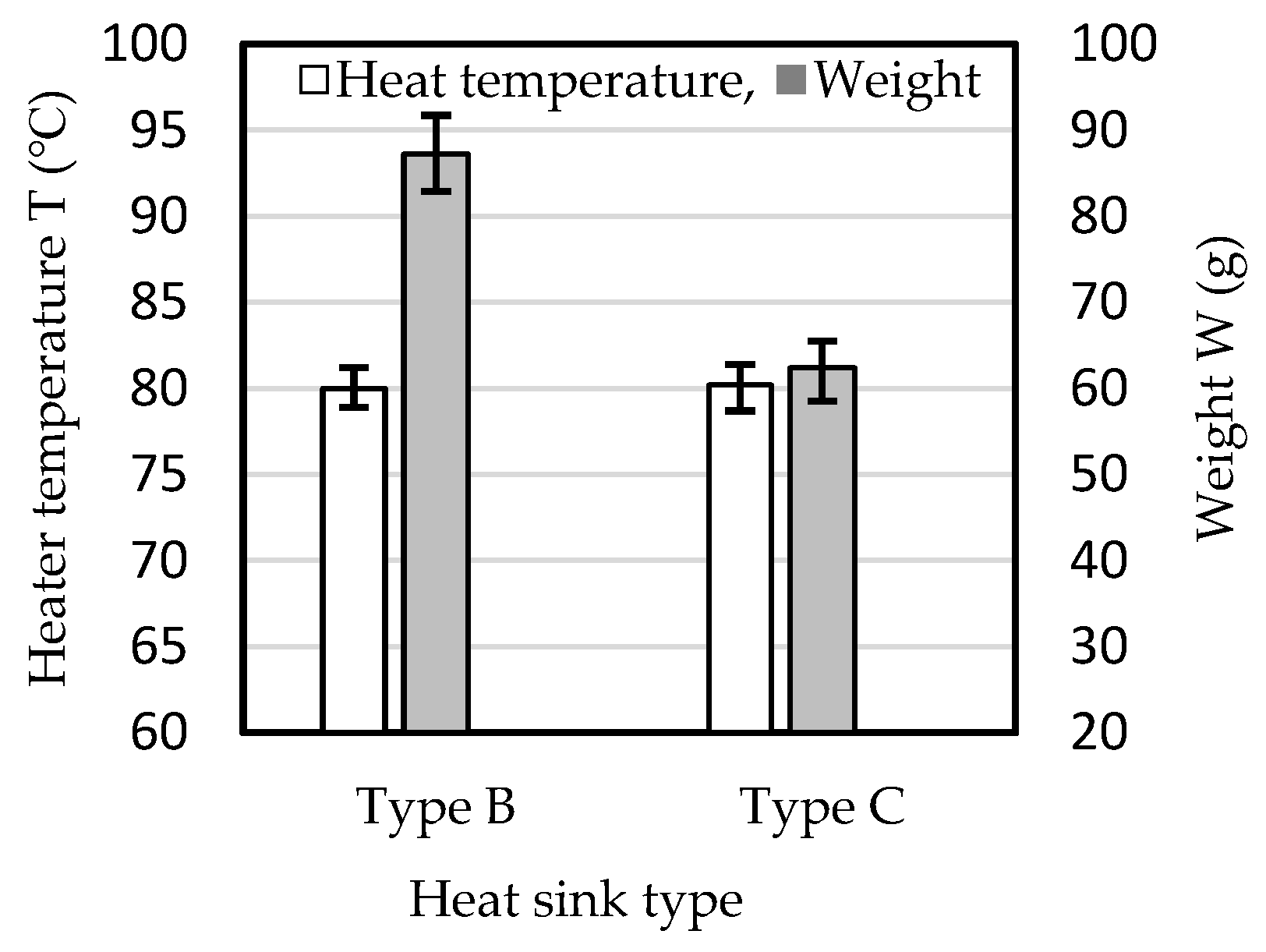

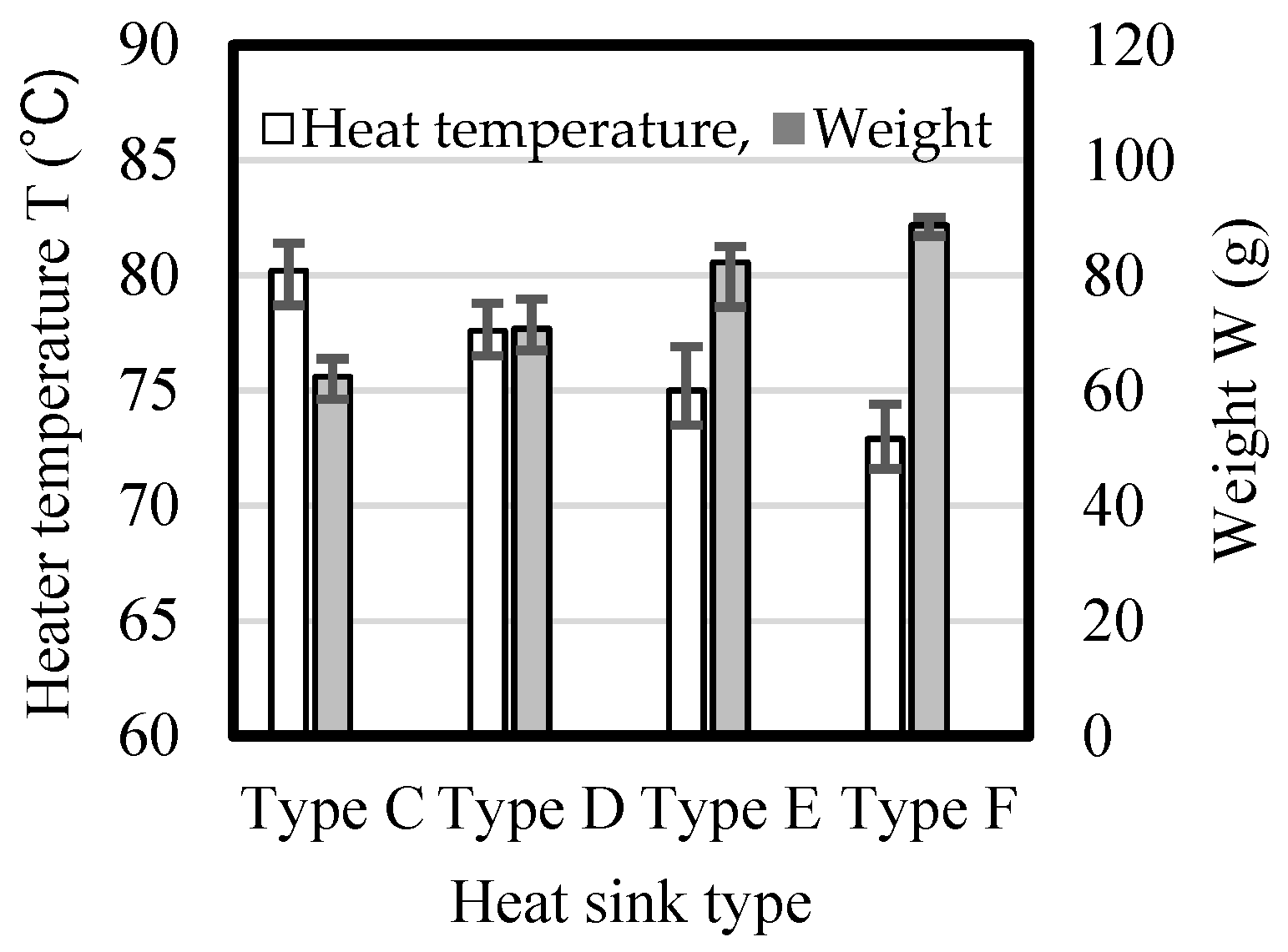
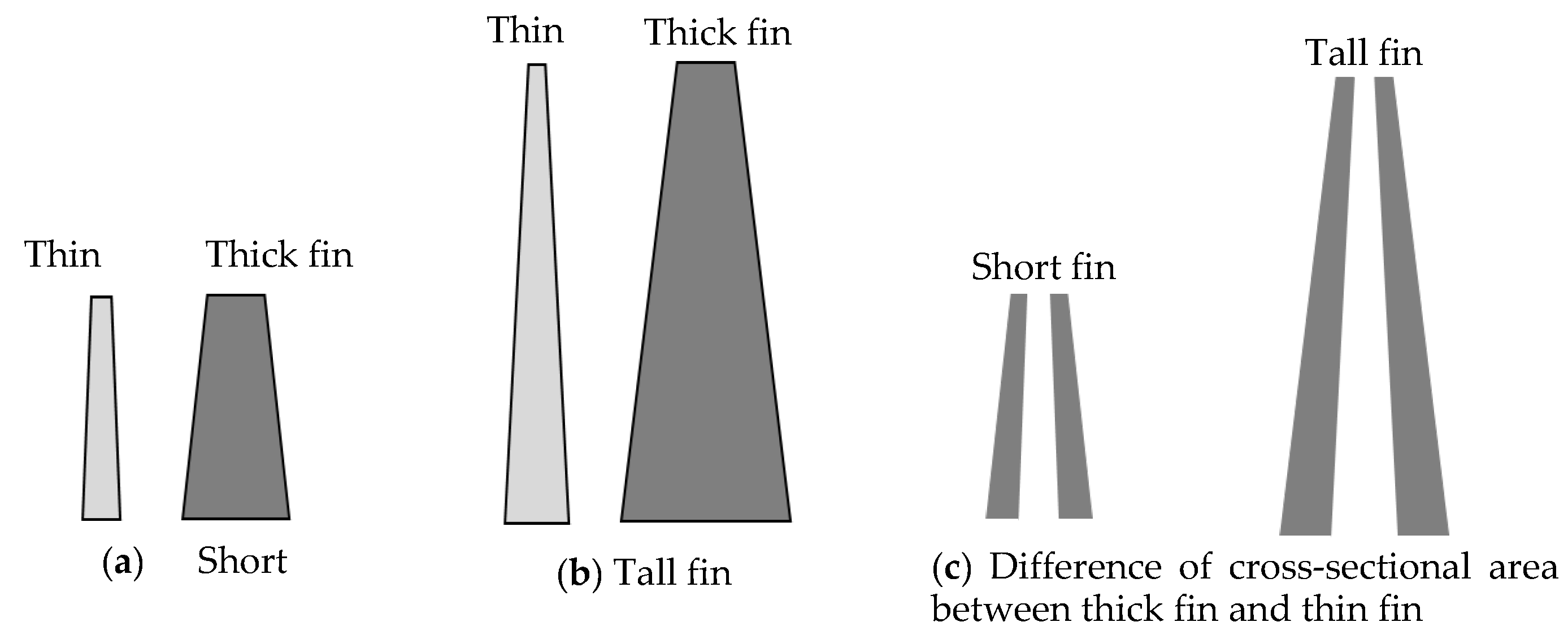

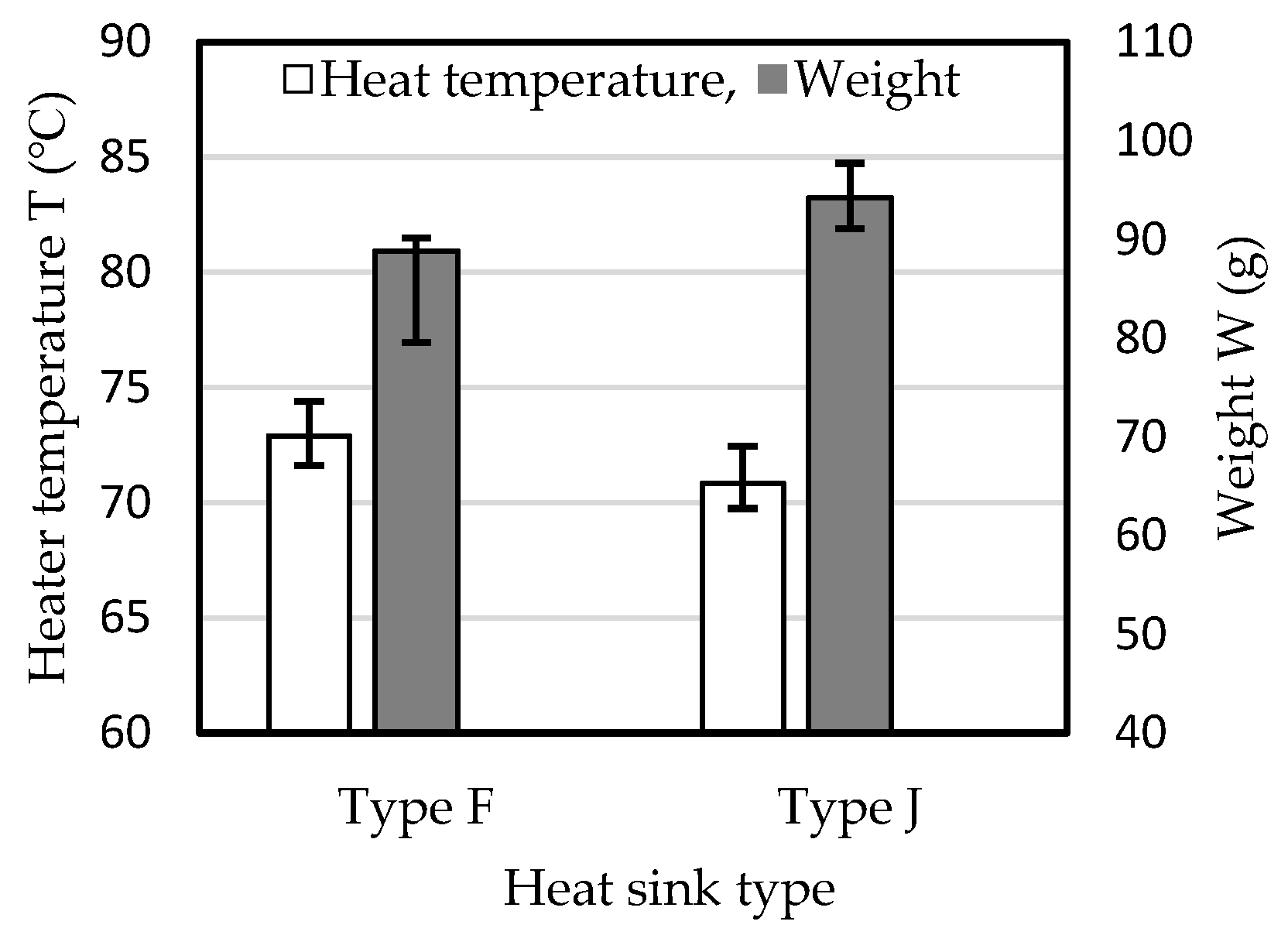
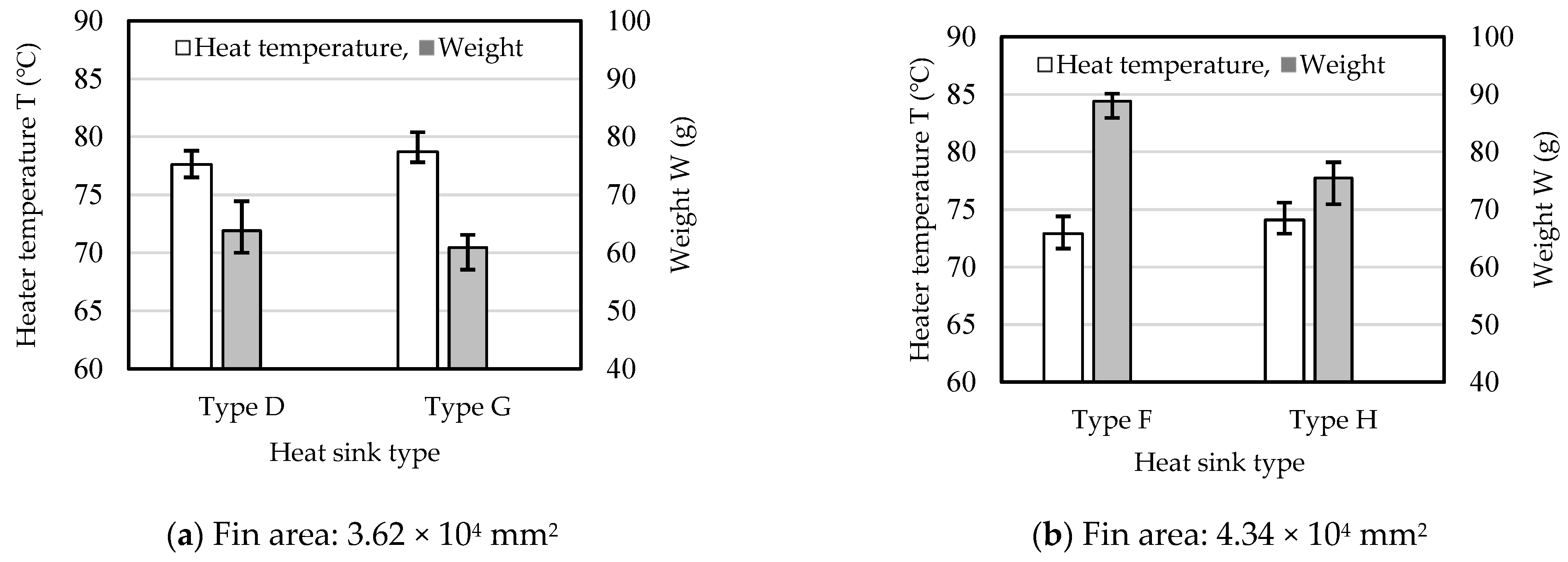
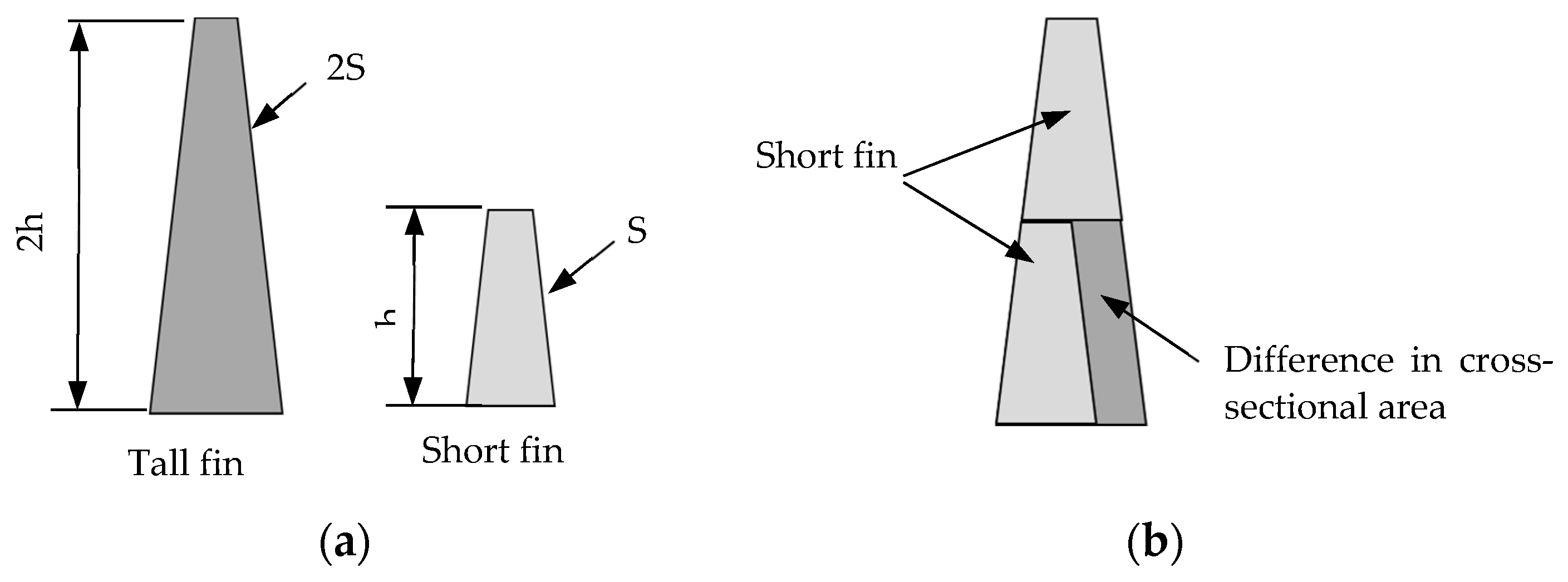
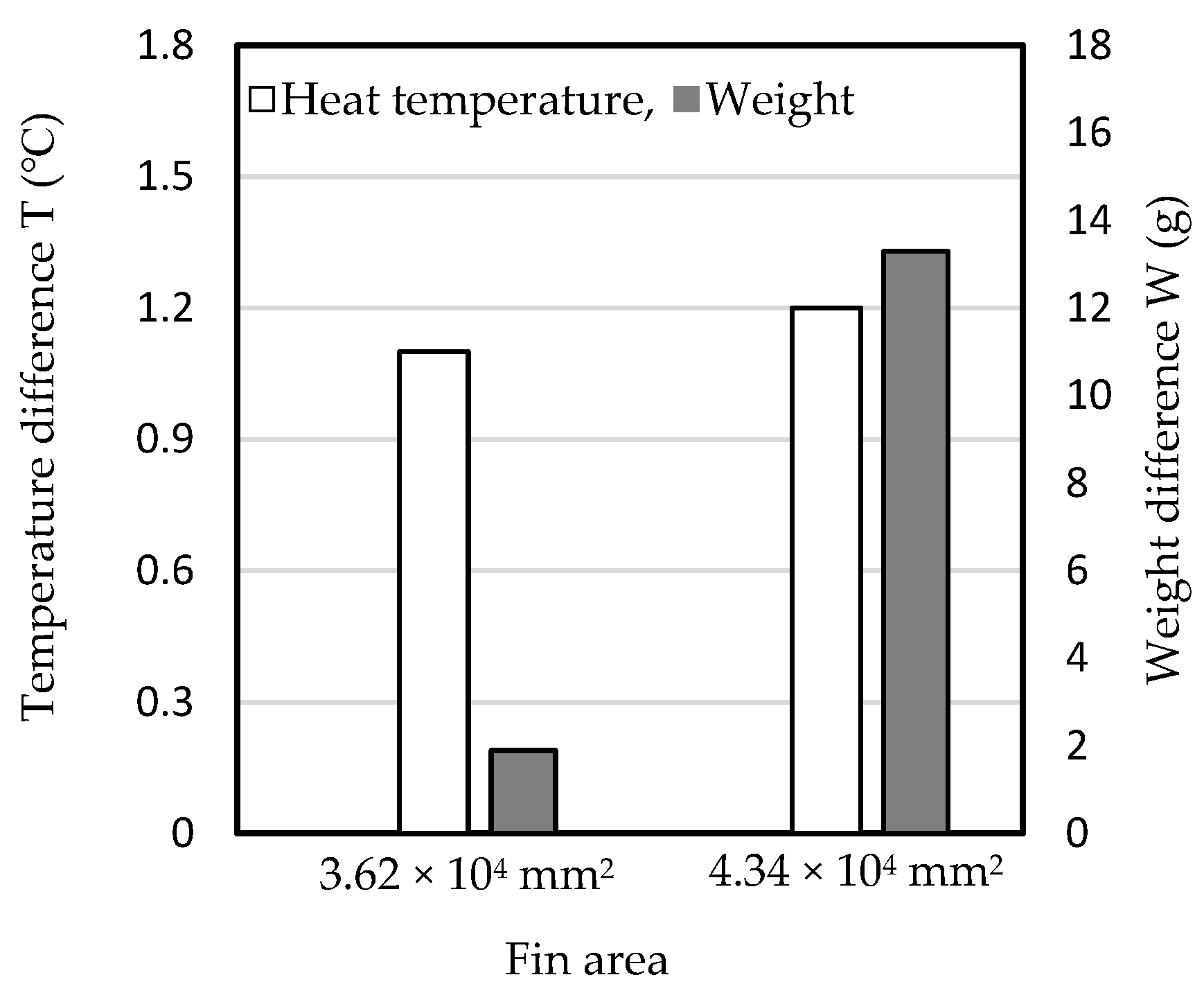
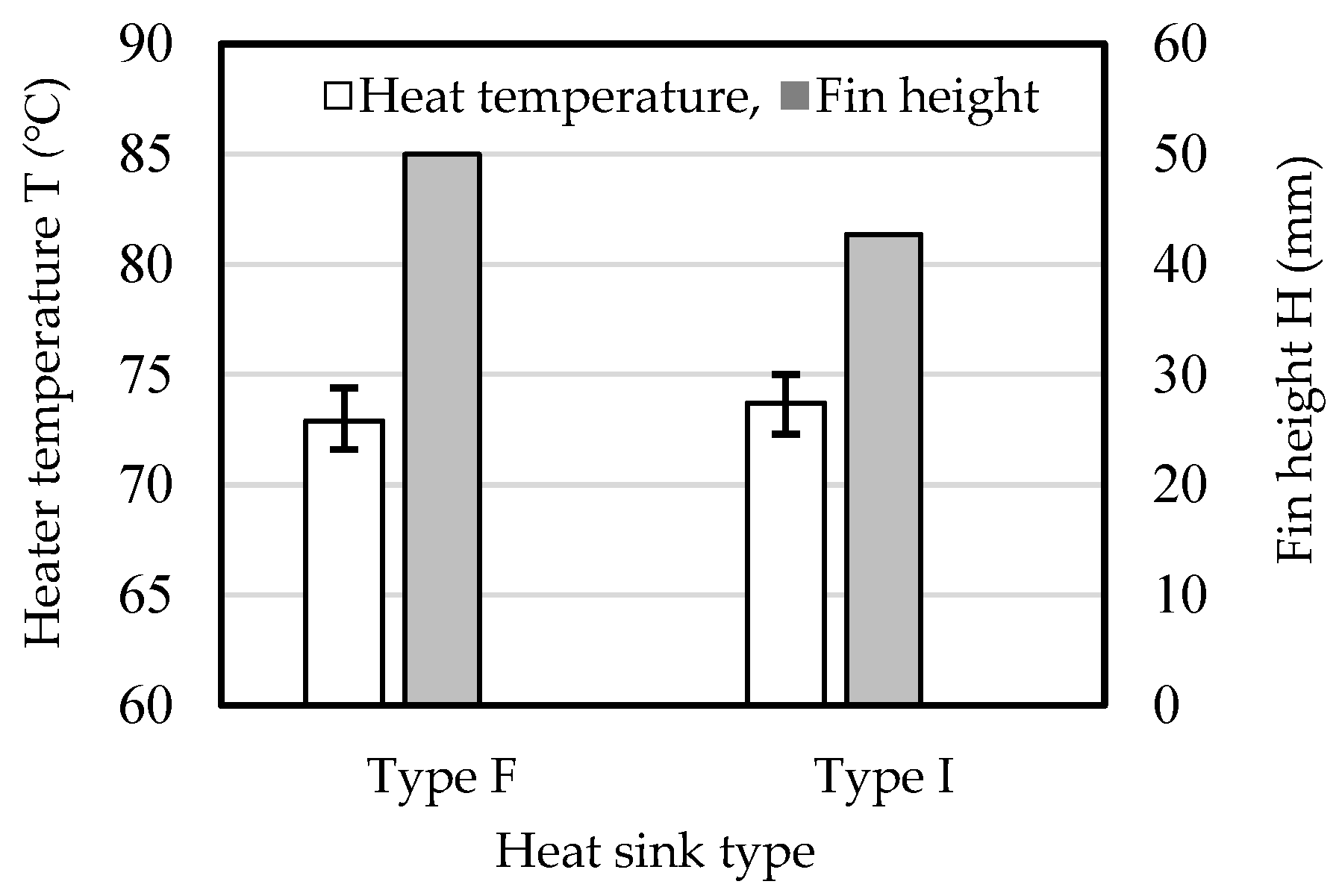
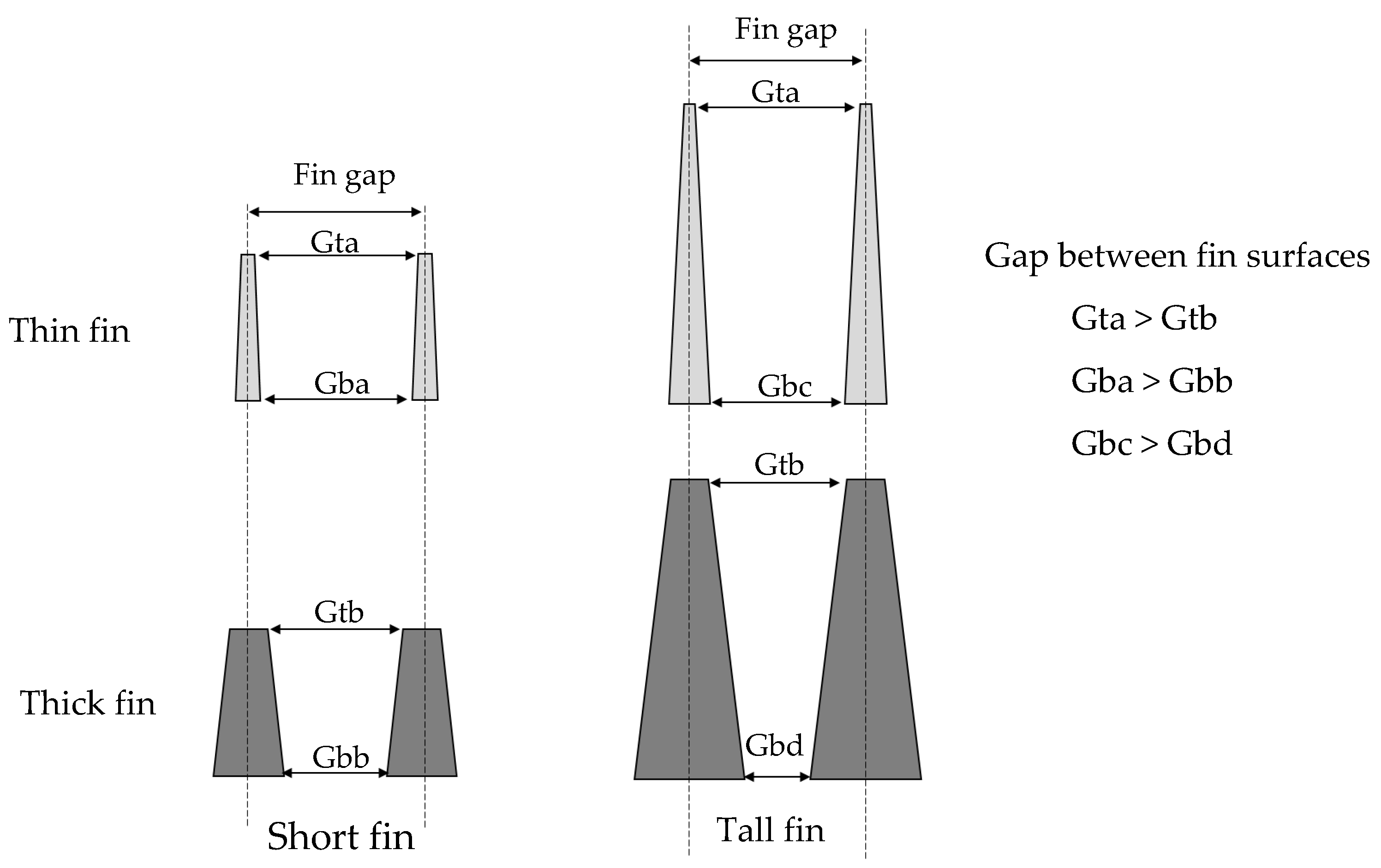
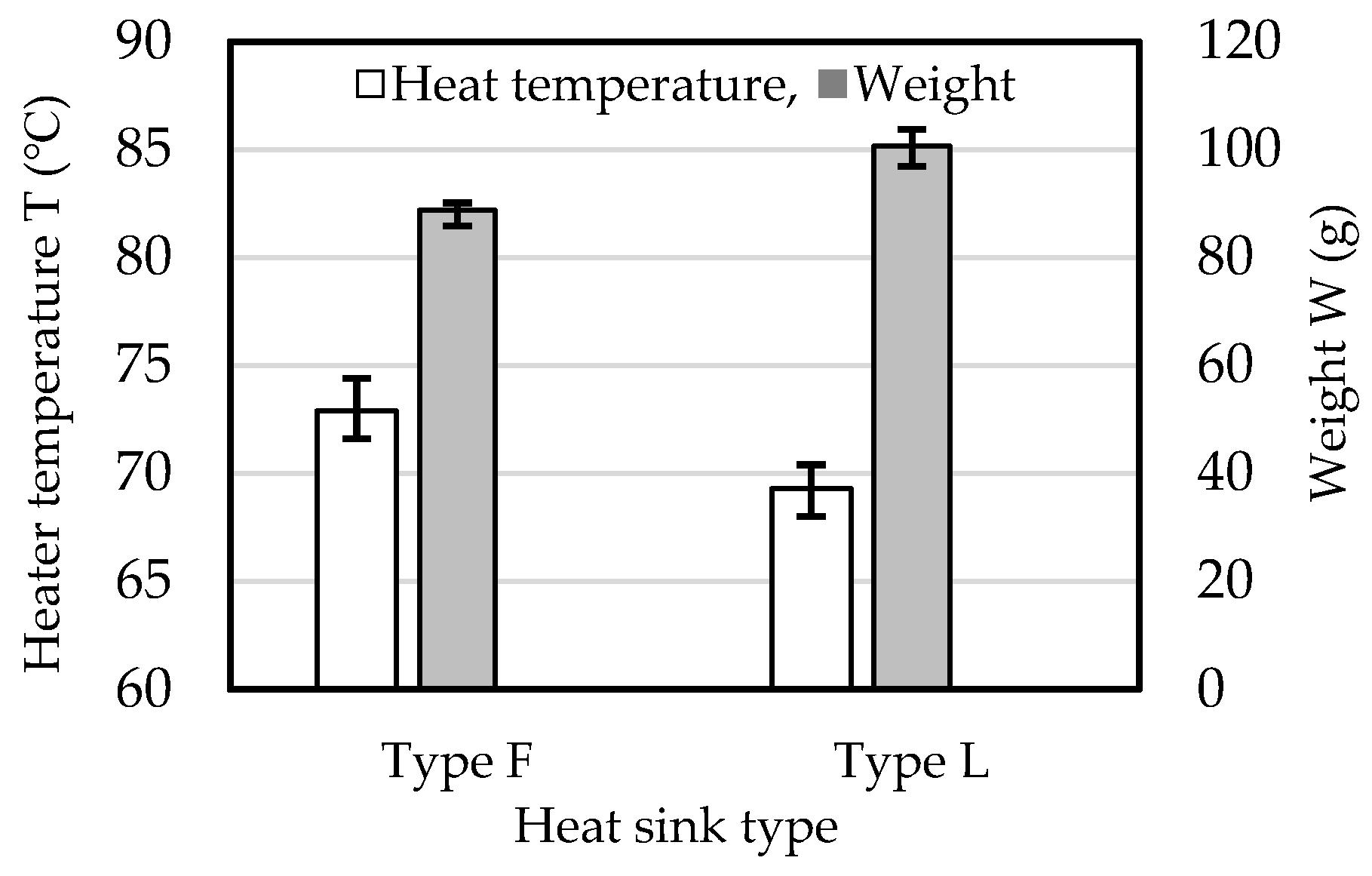
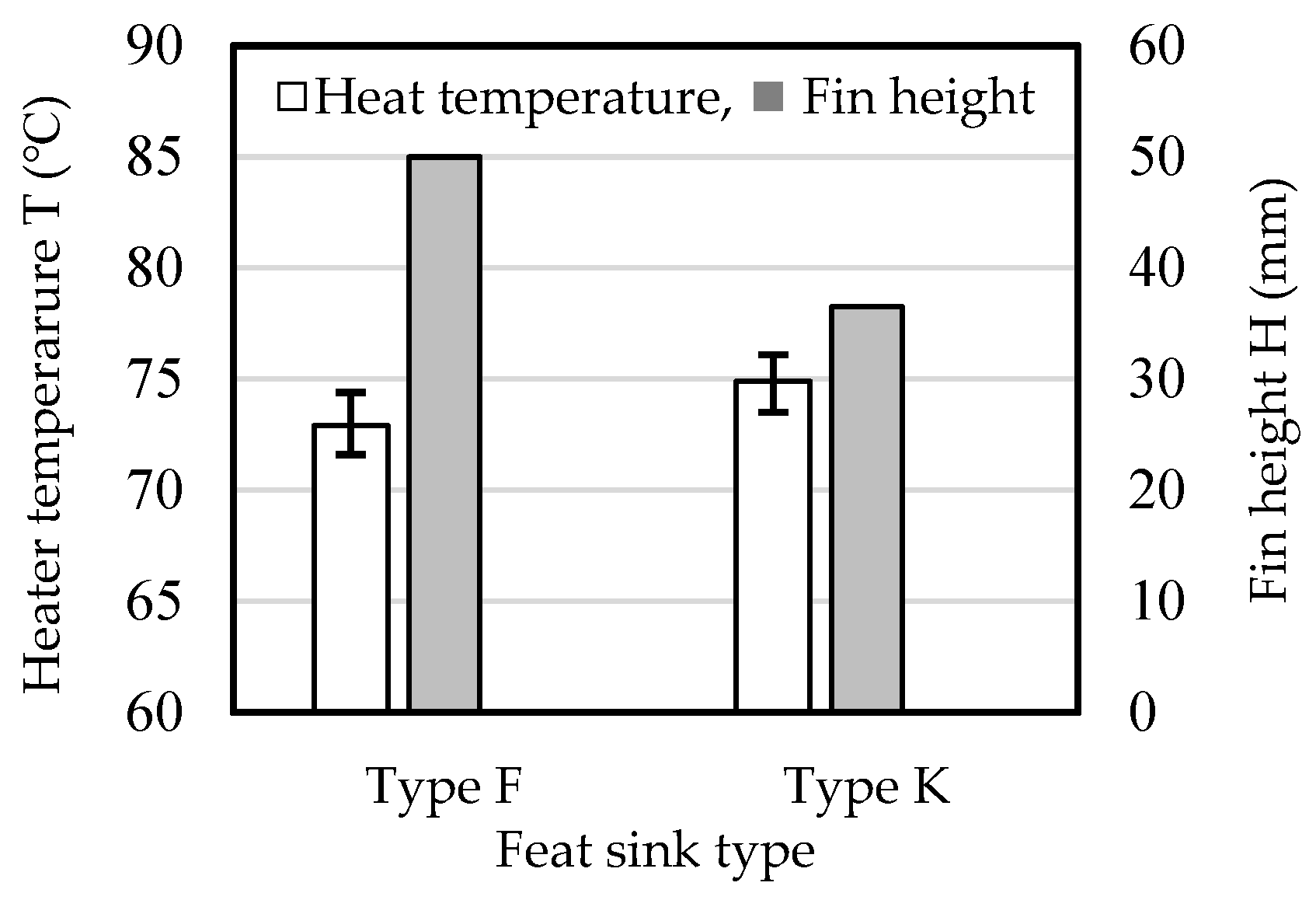
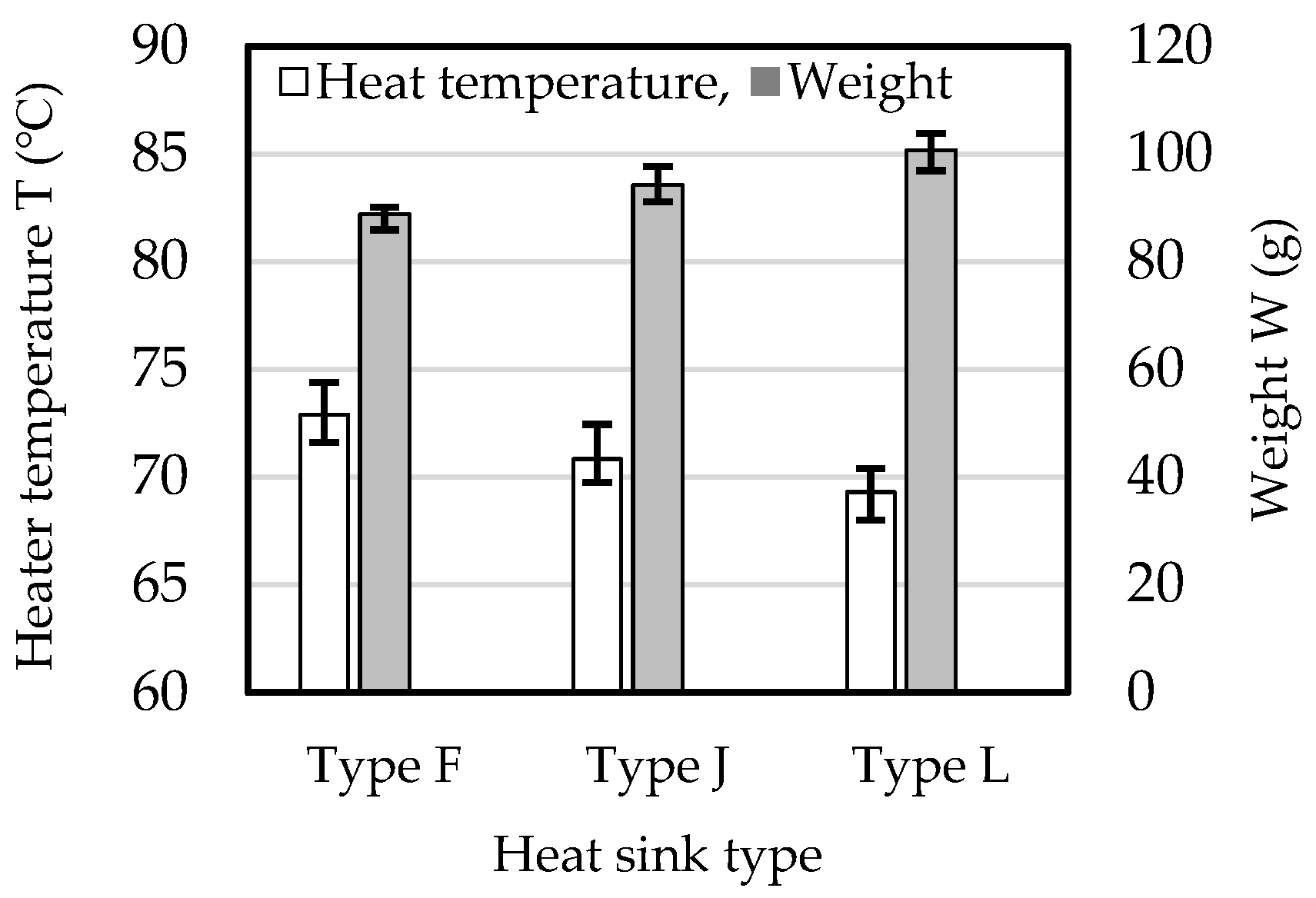
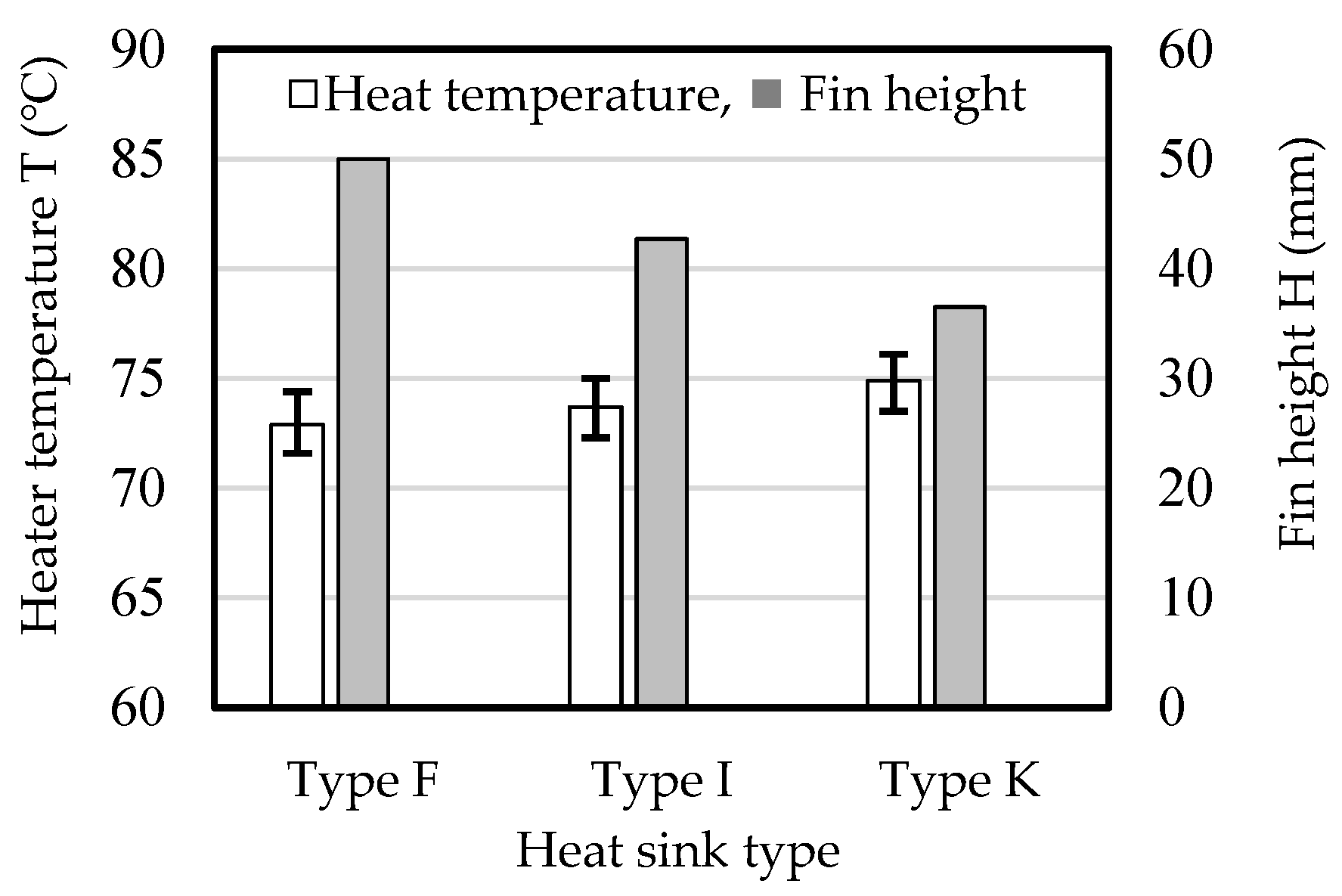


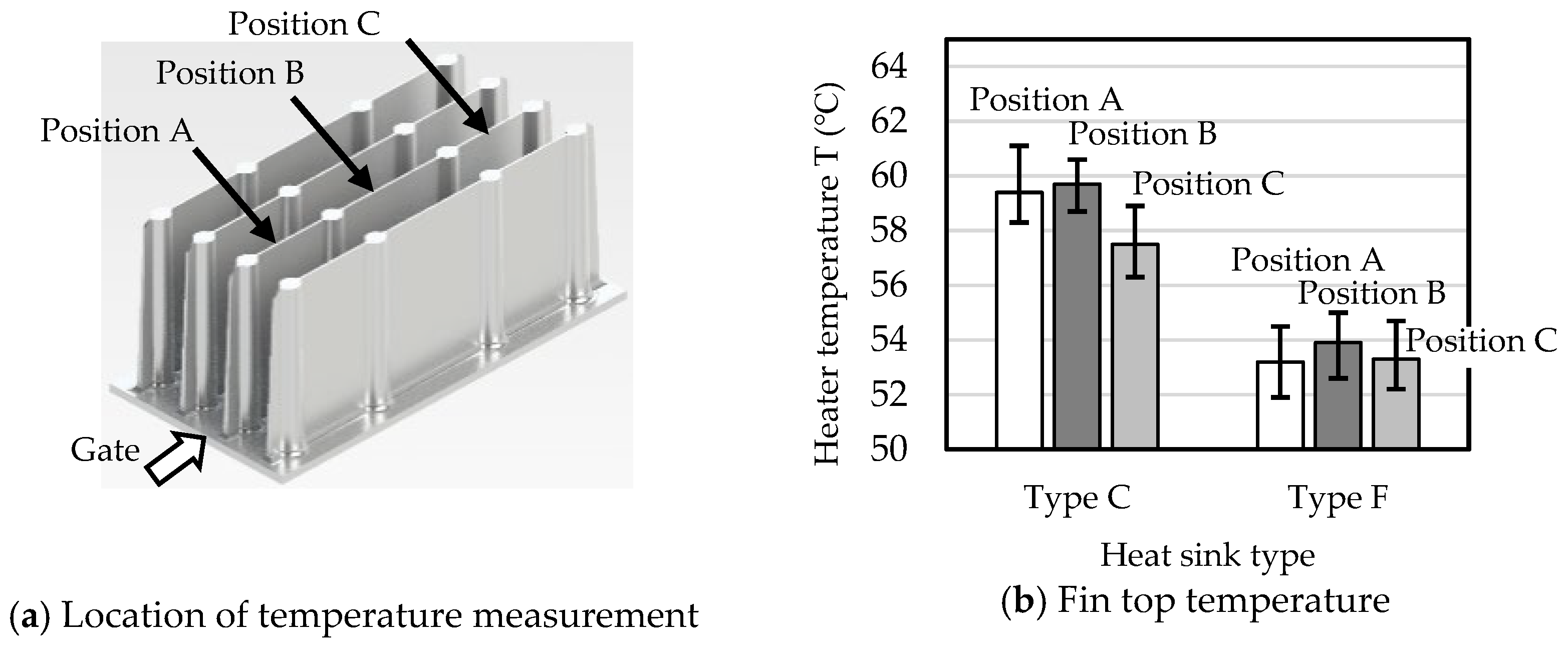



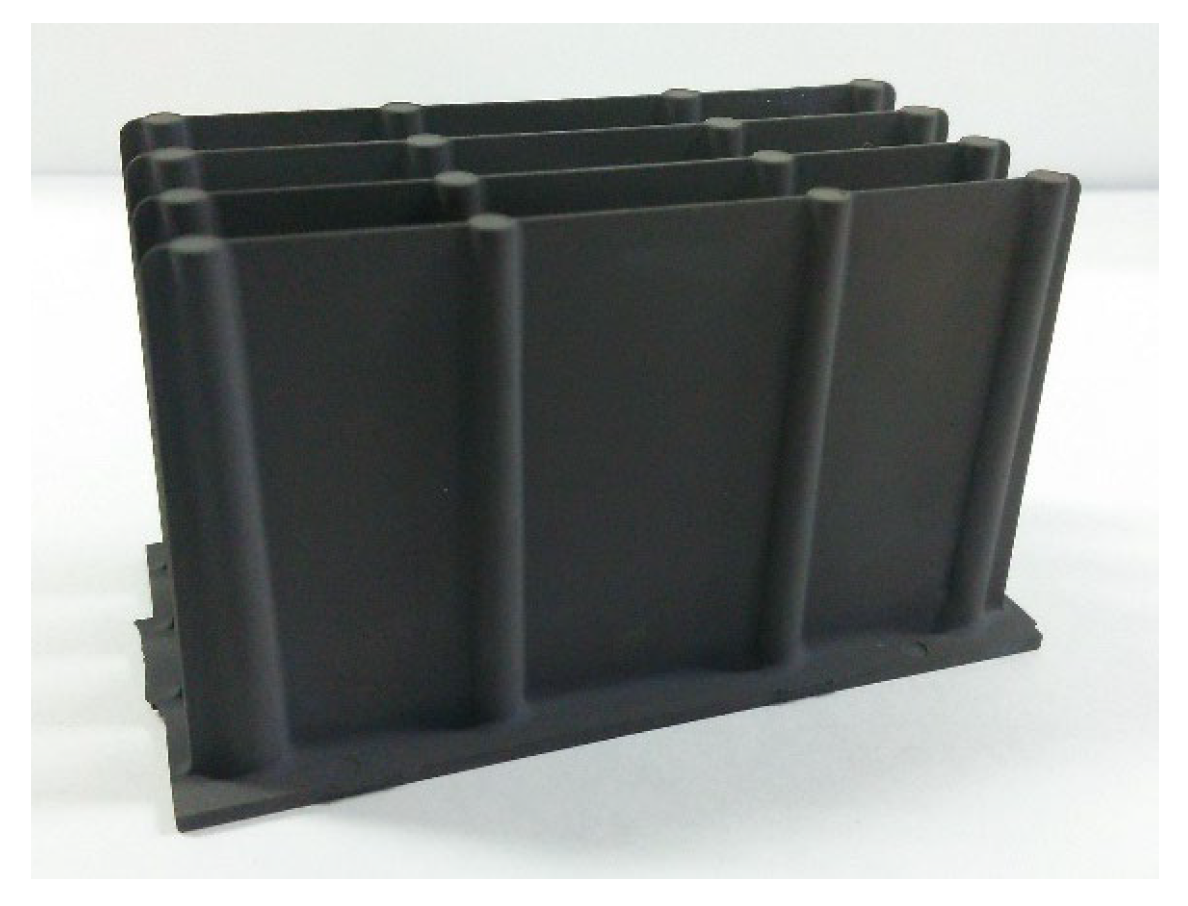
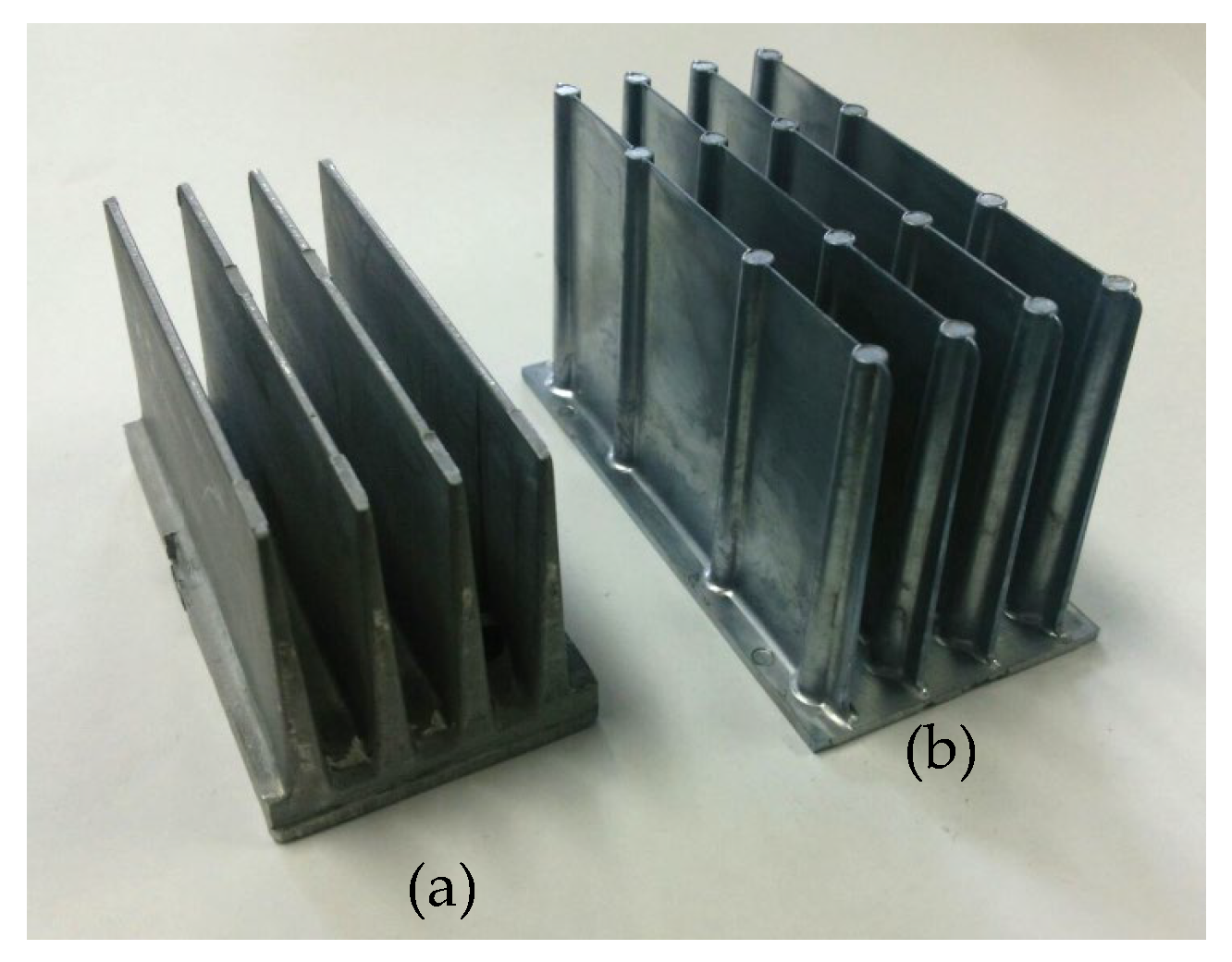
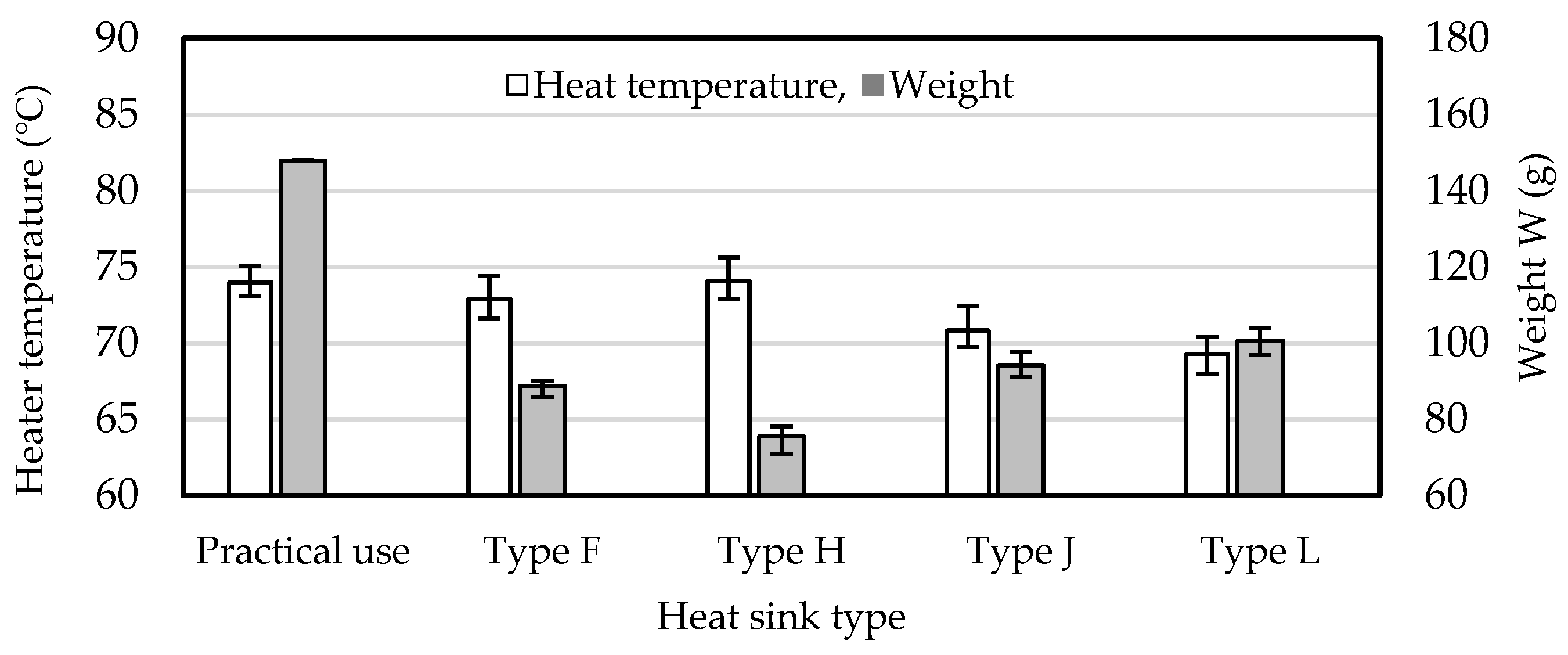
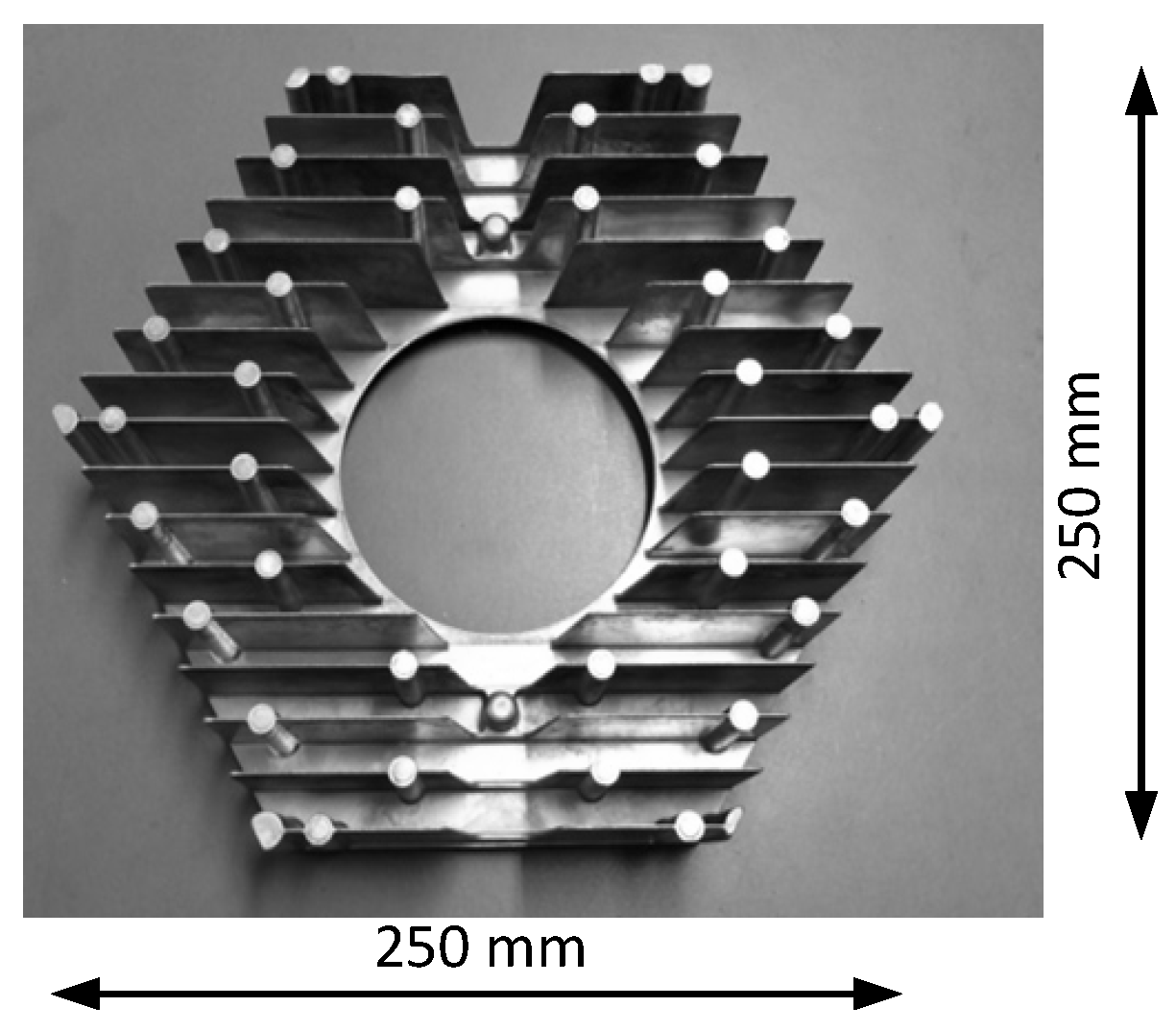
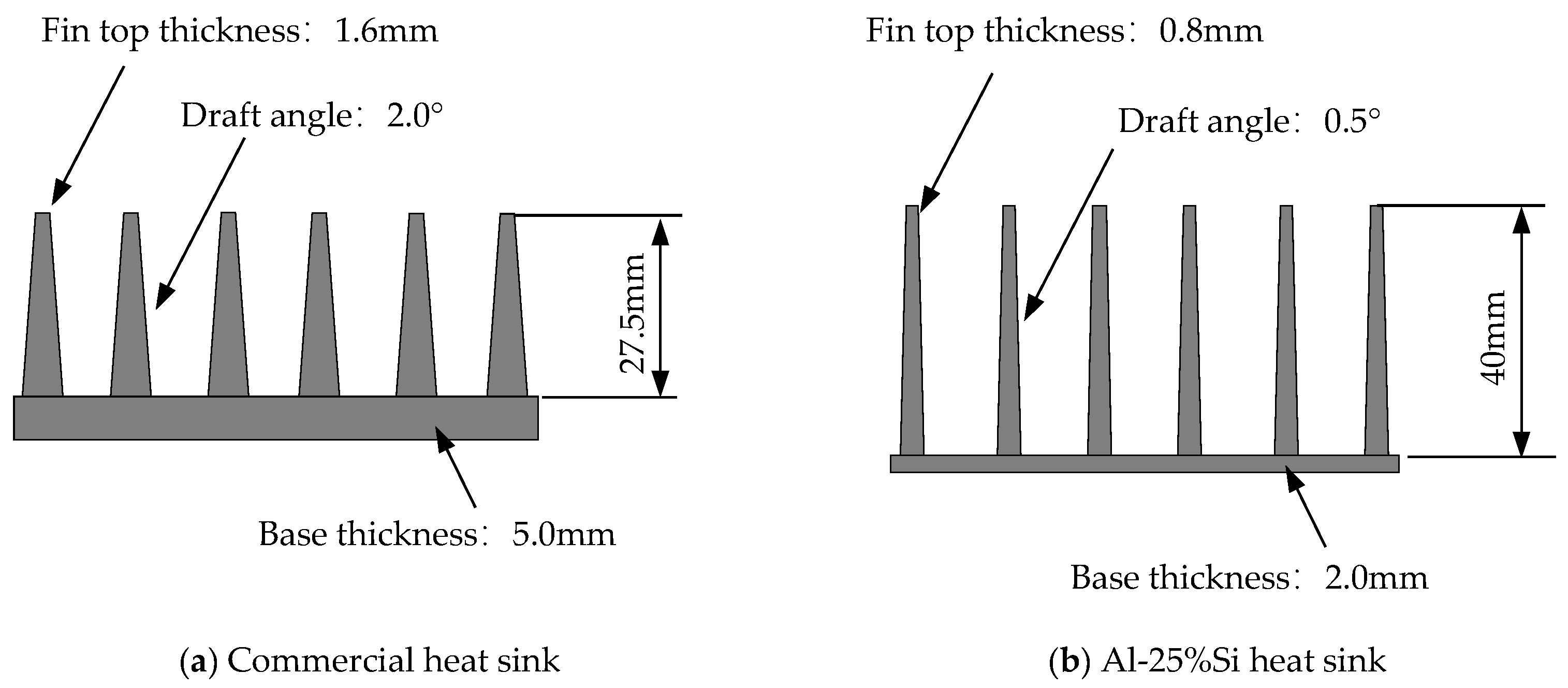
| Material | Si | Fe | Cu | Mg | Mn | Zn | Al |
|---|---|---|---|---|---|---|---|
| JIS ADC12 | 10.31 | 0.79 | 1.92 | 0.28 | 0.31 | 0.81 | Bal. |
| A-25%Si | 25.29 | 0.15 | 0.00 | 0.00 | 0.00 | 0.00 | Bal. |
| Type | Fin Height (mm) | Fin Top Thickness (mm) | Draft Angle of Fin (°) | Fin Gap (mm) | Number of Fin | Base Thickness (mm) |
|---|---|---|---|---|---|---|
| A | 20 | 1 | 1 | 11 | 4 | 2 |
| B | 35 | 1 | 1 | 11 | 4 | 2 |
| C | 35 | 0.5 | 0.5 | 11 | 4 | 2 |
| D | 40 | 0.5 | 0.5 | 11 | 4 | 2 |
| E | 45 | 0.5 | 0.5 | 11 | 4 | 2 |
| F | 50 | 0.5 | 0.5 | 11 | 4 | 2 |
| G | 32 | 0.5 | 0.5 | 8.3 | 5 | 2 |
| H | 40.5 | 0.5 | 0.5 | 8.3 | 5 | 2 |
| I | 42.7 | 0.5 | 0.5 | 8.3 | 5 | 2 |
| J | 50 | 0.5 | 0.5 | 8.3 | 5 | 2 |
| K | 36.5 | 0.5 | 0.5 | 11 | 4 | 4 |
| L | 50 | 0.5 | 0.5 | 11 | 4 | 4 |
| Fin Top Thickness (mm) | Fin Height (mm) | Fin Draft Angle (°) | Fin Spacing (mm) | Base Thickness (mm) | Base Width (mm) | Base Length (mm) |
|---|---|---|---|---|---|---|
| 1.5 | 35 | 3.5 | 10 | 7.3 | 40 | 70 |
Disclaimer/Publisher’s Note: The statements, opinions and data contained in all publications are solely those of the individual author(s) and contributor(s) and not of MDPI and/or the editor(s). MDPI and/or the editor(s) disclaim responsibility for any injury to people or property resulting from any ideas, methods, instructions or products referred to in the content. |
© 2024 by the authors. Licensee MDPI, Basel, Switzerland. This article is an open access article distributed under the terms and conditions of the Creative Commons Attribution (CC BY) license (https://creativecommons.org/licenses/by/4.0/).
Share and Cite
Haga, T.; Fuse, H. Die Casting of Lightweight Thin Fin Heat Sink Using Al-25%Si. Metals 2024, 14, 622. https://doi.org/10.3390/met14060622
Haga T, Fuse H. Die Casting of Lightweight Thin Fin Heat Sink Using Al-25%Si. Metals. 2024; 14(6):622. https://doi.org/10.3390/met14060622
Chicago/Turabian StyleHaga, Toshio, and Hiroshi Fuse. 2024. "Die Casting of Lightweight Thin Fin Heat Sink Using Al-25%Si" Metals 14, no. 6: 622. https://doi.org/10.3390/met14060622
APA StyleHaga, T., & Fuse, H. (2024). Die Casting of Lightweight Thin Fin Heat Sink Using Al-25%Si. Metals, 14(6), 622. https://doi.org/10.3390/met14060622





